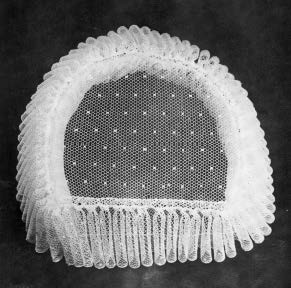The Legacy of Florence Nightingale at UMB
May 12, 2020 Tara Wink
May 12, 2020, marks the 200th birthday of Florence Nightingale, the founder of modern nursing.
UMB’s School of Nursing (SON) has ties to Florence Nightingale through its founder Louisa Parsons, an 1880 graduate of the Nightingale Training School for Nurses at the St. Thomas Hospital in London, which was founded by Nightingale in 1860.
The Florence Nightingale Cap was a tradition introduced by Parsons during her two-year term as the superintendent of the University Hospital Training School for Nurses. According to reports in the Nurses Alumnae Association Bulletin, the pattern of the “Flossie,” as the cap is lovingly referred, was given to Parsons by Nightingale to use when Parsons founded her first nursing school.
The cap was a signal to the Nursing School Graduates of their professionalism and they wore it proudly. An early graduate, Mary E. Cornman, Class of 1893, fondly remembered receiving her Flossie directly from Superintendent Parsons.
“I remember going to my rooms one night in the third week of March, 1891, and finding there the material for two uniforms and lace sufficient for two caps. The crowns of the caps were already cut out and the lace cut into proper lengths for both ruffles — 2¾ yards in the lower one (to go entirely around the crown), and 2¼ yards in the upper ruffle. The caps we first and second class nurses wore were larger in the crown than those worn now and the lace was sent from England.”
The Nightingale cap was traditionally made from point d’estprit lace, which was imported from England. By 1900, it was simplified by then- Superintendent Catherine A. Taylor to make it easier to clean and wear. In the 1930s, the lace became harder to find, so a simplified netting was approved for use by the Nursing Alumnae Association, the overseers of the Nightingale Cap. The Associations’ Bulletins routinely printed ads for purchase or laundering of the cap because it required special fluting tools and lace.
The Flossie is a proud tradition for SON alumni. Early on, senior students, in their final weeks of coursework, were shown how to string their caps in capping ceremonies. In later years students were taught how to flute their caps, during a six-week probationary period. If they were able to successfully flute the cap, the student could continue studies. These ceremonies were known as fluting ceremonies and continued into the 1980s. These fluting ceremonies eventually included skits and songs by the upper-class nurses.
To celebrate UMB’s Nursing Alumni Association’s 100th anniversary (see page 19), a Flossie was donated to the Smithsonian Institution. It remains a permanent item in the Smithsonian’s collection.
For many SON graduates, the Nightingale cap is a reminder of their role in a proud tradition of nursing. It ties them to the University of Maryland School of Nursing, its founder, Louisa Parsons, and Florence Nightingale. Years after graduating from the University Hospital Training School, Cornman still respected her Flossie and its symbolism. She stated:
“As Miss Parsons adjusted my cap, she placed it about 1½ inches beyond my forehead — and so I still wear it. A cap is a badge of service and when we consider all our cap means to us, we should want to wear it so that it will show, almost as a crown! This position for our cap should never have been changed. By wearing it in this dignified manner we show with pride our pleasure in ministering to minds and bodies diseased or broken in the rush of life.”
The year 2020 marks Nightingale’s 200th birthday. To honor her memory and influence, this year has been designated the International Year of the Nurse. UMB’s School of Nursing is an integral part of the proud tradition of nursing in Maryland and beyond.